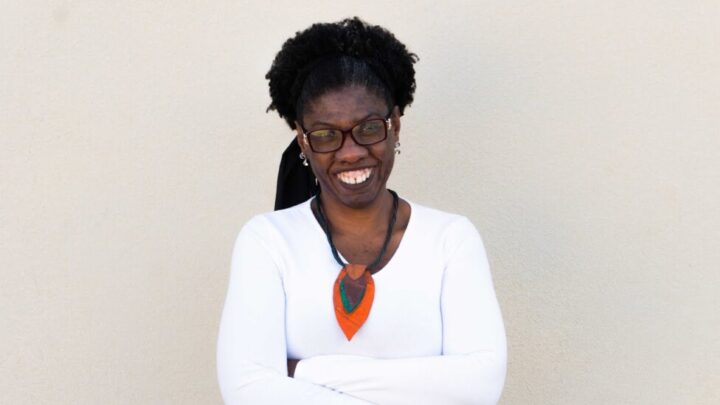
Women professors protested on Aug. 9 in Brasilia in front of the Ministry of Education, demanding better salaries in a sector where women are the vast majority, but face many barriers to promotion to better paid jobs, such as university teaching and scientific research, which in Brazil are concentrated in public universities. CREDIT: Joédson Alves/Agência Brasil-FotosPúblicas
By Mario Osava
RIO DE JANEIRO, Aug 22 2023 – “I thought of studying journalism, because of the example of Gloria Maria,” a famous black TV journalist who died of cancer in February 2023, said mathematician Luciana Elias, while discussing the scarce female participation in exact sciences research in Brazil.
“There are no visible examples, female role models in scientific research, where there are white men, not women, let alone black women,” she said. This lack of representation blocks girls’ access from childhood to academic careers that are still perceived as “masculine,” the 52-year-old professor pointed out.”There are no visible examples, female role models in scientific research, where there are white men, not women, let alone black women.” Luciana Elias
Because she loved mathematics, Elias followed her vocation. She graduated in 1995, and earned a master’s degree and doctorate in exact mathematics at several Brazilian universities, later becoming a professor of this pure science at the Federal University of Jataí.
“At the graduation ceremony, there were only three women and I was the only black woman,” she told IPS by telephone from Jataí, a city of 105,000 people in the midwest Brazilian state of Goiás.
Women have excelled in educational advancement in Brazil, a country of just over 203 million people. In 1970 they made up only 25.6 percent of Brazilians graduating from university. By the year 2000 they represented 52.8 percent. This trend has continued, although at a slower pace.
Lagging behind in mathematics
But in mathematics, applied and computational mathematics and statistics, there was a small reduction in female participation between 2009 and 2019, according to a special bulletin released in May by the Gender and Diversity Commission of the Brazilian Societies of Mathematics (SBM) and Applied and Computational Mathematics (SBMAC).
From 53 percent of female graduates in 2009, the proportion dropped to 47 percent in 2019.
The percentage of women is even lower in the so-called baccalaureate, which in Brazil refers to a bachelor’s degree required to practice a profession, while a different kind of bachelor’s degree trains future professors.
Female baccalaureate degree holders in mathematics and related fields dropped from 43 percent to 37 percent between 2009 and 2019, according to the study, while those graduating specifically to teach dropped from 55 percent to 48 percent in the same period.
In computer science the situation is worse: “I know a student who was the only woman in her group of 40 students at graduation,” said Marilaine Colnago, PhD in computational mathematics and professor of that discipline at the Paulista State University (UNESP) in Araraquara, a city of 242,000 inhabitants in the state of São Paulo.
“Many female students drop out because they feel isolated,” she lamented, saying that the lack of women in careers such as engineering and computer science is the first barrier to women’s entry into universities to take courses in the exact sciences.
“There were many women in the beginning, when there were only the big computers, for calculations and secretarial services. Then, with personal computers and advances in computing, it became a purely male area,” said Colnago, the head of SBMAC’s “Women in Applied and Computational Mathematics” committee.
Women have been a majority in Brazilian universities since the end of the last century. But in addition to being a minority in higher income professions, such as engineering and computer science, they suffer from the so-called “scissors effect”, which prevents them from moving up the career ladder, especially in scientific research.
“At graduation, we make up about half of the students; at the doctoral level, women are down to 20 percent,” said Colnago, 34.

Luciana Elias is a professor of exact mathematics, a discipline in which she holds a PhD, at the Federal University of Jataí in midwest Brazil. She represents a small minority in pure science, especially in mathematics, where women have a scarce presence and are mainly engaged in teaching primary and middle school. CREDIT: UFJ
Maternity as a stumbling block
Maternity is one of the notable factors in the low presence of women in research. The Minister of Science, Technology and Innovation, electrical engineer Luciana Santos, the first woman to hold this position in the country, announced that she would promote “affirmative action” to ensure postgraduate scholarships for women scientists.
In addition to specific resources for women researchers equivalent to 20 million dollars over the next four years, she promised to modify the criteria for scholarships, respecting, for example, the question of maternity.
Until now, pregnant women lose points for productivity-based scholarships, because their evaluation considers the period of pregnancy and maternity leave as an interruption of their work.
Women researchers are faced with the dilemma between motherhood and a career, since the still dominant culture assigns women to care work and teaching, which is less well paid. They are also in the majority in nursing, but in the minority among physicians.
Added to that are “invisible barriers,” such as sexual harassment, a male environment with its prejudices, jokes and the silencing of female voices.
There have been advances in combating these issues, which previously “could not be spoken up about,” but they continue to hinder the promotion of women in the academic world, said Colnago, who is married and has no children.
She personally felt the difference in treatment between the master’s degree, where she had an understanding and friendly adviser, and the PhD that she earned in a more masculine world, as it was in computer science, “where there is different treatment for men and women.”

A meeting in Brasilia of the rectors of Brazil’s public universities with President Luiz Inácio Lula da Silva, which shows that most of the top university authorities are men, despite the fact that the majority of the university population is female. Luciana Santos, the first woman to hold the post of Minister of Science, Technology and Innovation, next to the president in the foreground, represents a hope for a greater female presence in the exact sciences. CREDIT: Ricardo Stuckert / PR
Losses
“Scientific research, like all innovation projects, loses the diversity of views, the different visions of gender and race, which are fundamental,” by excluding a more effective participation of women and different ethnicities, said the professor of computational mathematics in the chemistry course at UNESP.
“We are losing female researchers with good projects because they see motherhood as a negative and because of a lack of incentives and public policies,” Colnago complained.
It is necessary to give visibility to female advances in the scientific area, to highlight women who made good contributions to science “that will inspire other women to follow their vocations,” she said.
This is what the SBM/SBMAC Gender and Diversity Commission, created in 2019, seeks in order to reduce gender differences and promote the diversity of actors in mathematics in Brazil.
A positive measure taken by SBMAC at its annual congresses was to set up a space to care for the children of the participants, so that their fathers and mothers could have equal conditions to discuss the topics of their work.
In Elias’s view, the first step, already partially accomplished with the bulletin on “gender and race” in mathematics, is to recognize existing gender disparities in the exact sciences.
The next would be to propose “institutional, public” actions to overcome inequalities, dismantle the myth that “men are more capable,” disseminate positive examples of women, and increase forums for debate on the subject.
It is also necessary to reduce regional imbalances, the professor said, pointing out that her city, Jatai, is more than 300 kilometers from an airport and has few resources to promote science.
“Society is losing brilliant minds that fail to fulfill their vocations and Brazil is giving up potential intellectuals” by failing to address gender and racial inequalities in scientific development as it should, she argued.